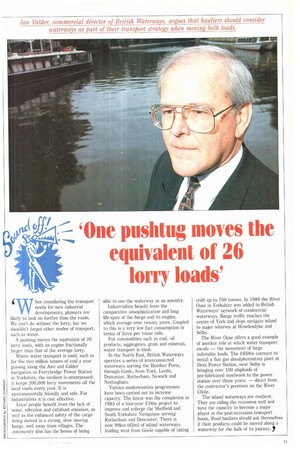'One imshtug moves the equivalent of 26 lorry loads'
Page 53

If you've noticed an error in this article please click here to report it so we can fix it.
hen considering the transport needs for new industrial developments, planners are likely to look no further than the roads. We can't do without the lorry, but we shouldn't forget other modes of transport, such as water.
A pushtug moves the equivalent of 26 lorry loads, with an engine fractionally larger than that of the average lorry, W,here water transport is used, such as for the two million tonnes of coal a year passing along the Aire and Calder navigation to Ferrybridge Power Station in Yorkshire, the medium is unsurpassed: it keeps 200,000 lorry movements off the local roads every year. It is environmentally friendly and safe. For industrialists it is cost effective.
Local people benefit from the lack of noise, vibration and exhahust emission, as well as the enhanced safety of the cargo being moved in a strong, slow moving barge, well away from villages. The community also has the bonus of being able to use the waterway as an amenity.
Industrialists benefit from the comparative unsophistication and long life-span of the barge and its engine, which average over twenty years. Coupled to this is a very low fuel consumption in terms of litres per tonne mile.
For commodities such as coal, oil products, aggregates, grain and minerals, water transport is ideal.
In the North East, British Waterways operates a series of interconnected waterways serving the Humber Ports, through Goole, from York, Leeds, Doncaster, Rotherham, Newark and Nottingham.
Various modernisation programmes have been carried out to increase capacity. The latest was the completion in 1983 of a four-year £16m project to improve and enlarge the Sheffield and South Yorkshire Navigation serving Rotherham and Doncaster. There is now 99km (62m) of inland waterways leading west from Goole capable of taking craft up to 700 tonnes. In 1989 the River Ouse in Yorkshire was added to British Waterways' network of commercial waterways. Barge traffic reaches the centre of York and ships navigate inland to major wharves at Howdendyke and Selby.
The River Ouse offers a good example of another role at which water transport excels — the movement of large indivisible loads. The £658m contract to install a flue gas desulphurisation plant at Drax Power Station, near Selby is bringing over 100 shiploads of pre-fabricated steelwork to the power station over three years. — direct from the contractor's premises on the River Clyde.
The inland waterways are resilient. They are riding the recession well and have the capacity to become a major player in the post-recession transport boom. Road hauliers should ask themselves if their products could be moved along a waterway for the bulk of its journey. y
























































































